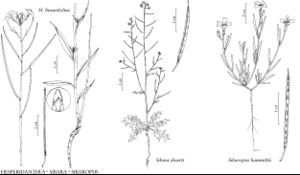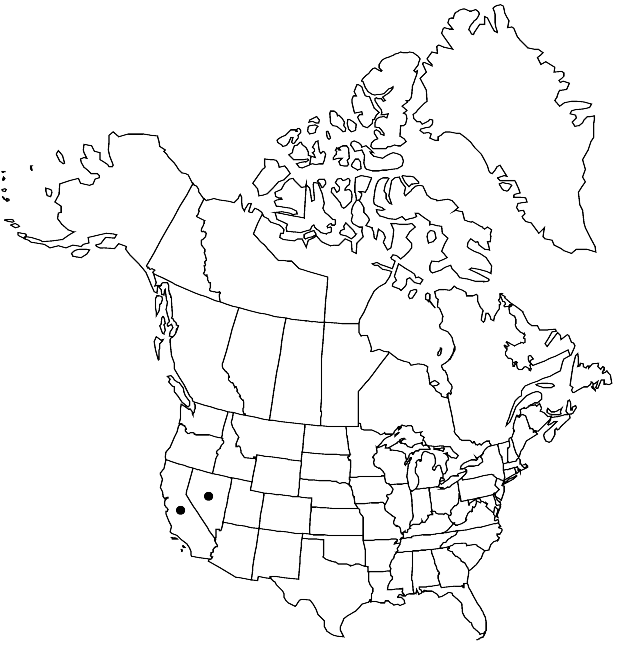Sibara deserti
Contr. Gray Herb. 165: 140. 1947.
Plants sparsely to moderately puberulent, trichomes 0.05–0.3 mm. Stems often branched distally, 1–3.5(–4.5) dm, puberulent or glabrous. Basal leaves sometimes withered by flowering; rosulate or not. Cauline leaves: petiole 5–1.7 cm; blade (distal linear), margins pinnatisect: lobes linear to linear-lanceolate, 0.2–2 cm × 0.3–3 mm, margins entire, (surfaces glabrous or puberulent). Racemes (corymbose), rachis straight. Fruiting pedicels divaricate or horizontal to reflexed, straight, recurved, or curved upward, (2–)3–5.5(–10) mm, glabrous or puberulent. Flowers: sepals 1.5–2 × 0.5–0.7 mm, puberulent; petals white, 2–3.5 × 0.5–1 mm, claw ca. 1.5 mm; median filaments 1.2–1.5 mm; anthers ovate, 0.3–0.4 mm. Fruits divaricate-ascending to spreading or reflexed, often curved, smooth, (0.8–)1.2–2.5(–3.2) cm × 1.2–1.5 mm; valves puberulent or glabrous; ovules 16–24 per ovary; style 1–2.5(–3) mm. Seeds 0.9–1.4 × 0.6–0.9 mm. 2n = 26, 28.
Phenology: Flowering Mar–Apr.
Habitat: Steep talus or rocky slopes, dry creosote bush flats, deserts, rocky bluffs, rock detritus, calcareous debris, exposed crevices, steep banks
Elevation: 150-1200 m
Discussion
California collections examined are from Inyo County, and the only Nevada material I have studied is the type collection, from Amargosa Desert in southern Nye County.
R. C. Rollins (1947, 1993) separated Sibara deserti from S. rosulata primarily by having pendent to reflexed fruits less than 1–1.5 cm (versus divaricate-ascending fruits 1.5–3 cm), slender (versus club-shaped) styles, and presence (versus absence) of basal rosettes. These characters show continuous variation from one extreme to the other and are found in various combinations. The length and orientation of fruits can vary substantially in a single population or even on the same plant. For example, in Rollins & Munz 6743 and Rollins & Munz 6744 (both at GH and collected from the same general area) the fruits are ascending, divaricate, or reflexed and are 1.5–2.5 cm. Styles can be slender to stout, cylindrical to slightly club-shaped, and 1–3 mm; their considerable variation is independent of fruit length and orientation. Sibara deserti and S. rosulata are identical in leaf and trichome morphology, flower color and size, seed size, the overall range of variation in fruit size and length, and the orientation of fruiting pedicels. The complex represents a single species easily distinguished from the remaining North American members of Sibara by having minute, dendritic to forked (instead of simple) or no trichomes.
Selected References
None.

